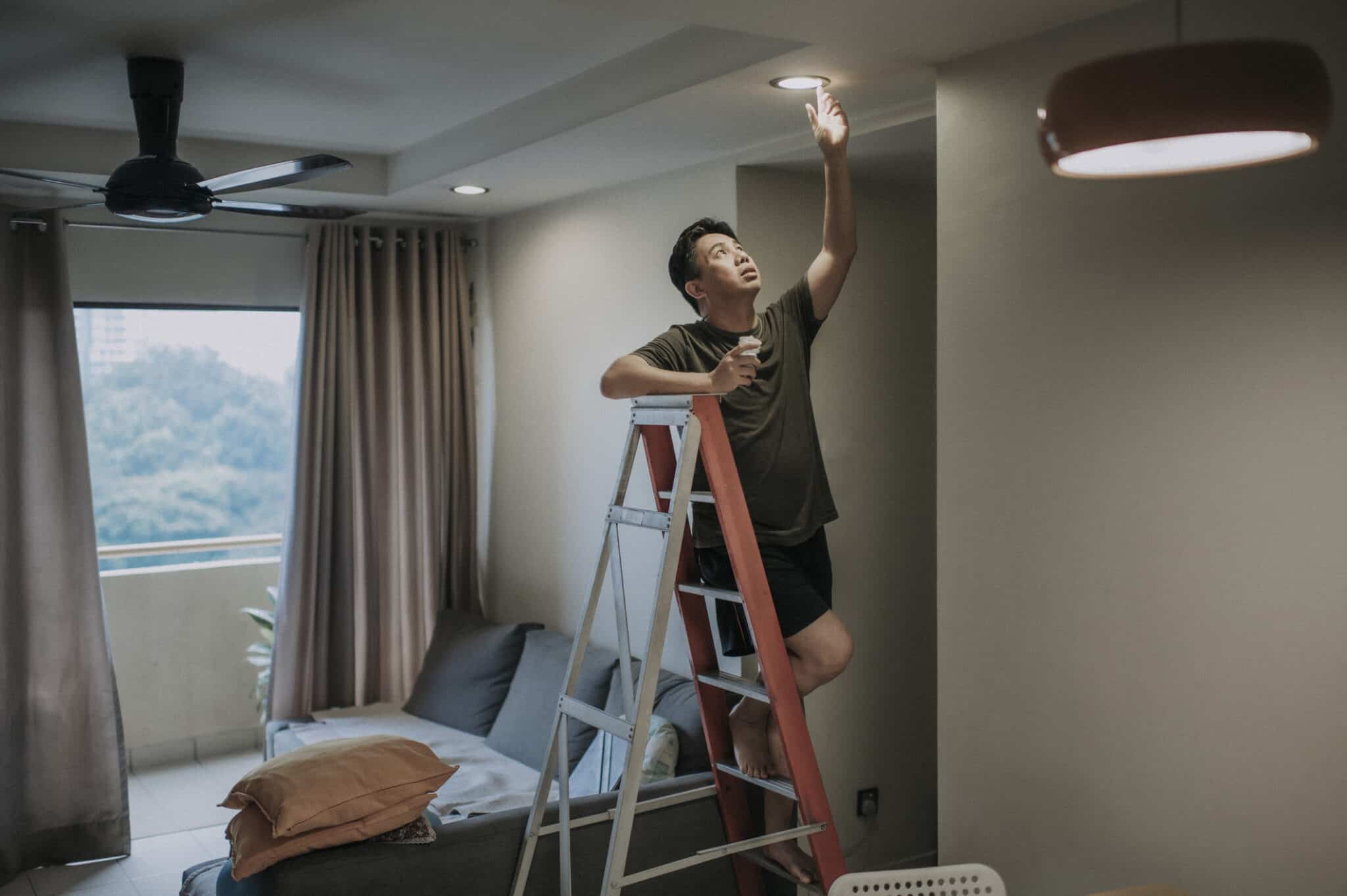Switching to LED lighting is a smart move that saves money, improves your home’s brightness, and benefits the environment. Here are five top reasons to upgrade:
- Energy Efficiency: LEDs use up to 75% less energy than incandescent bulbs, lowering electricity bills and reducing your carbon footprint.
- Longer Lifespan: LEDs last up to 50,000 hours, meaning fewer replacements and long-term cost savings.
- Environmental Benefits: LEDs use less energy, reduce waste, and contain no toxic materials like mercury.
- Improved Lighting Quality: Enjoy better color rendering, adjustable brightness, and flicker-free light.
- Increased Safety: LEDs emit less heat, reducing fire risks and enhancing visibility.
Upgrade to LED lighting for a brighter, safer, and more energy-efficient home!

Noticing your light bulbs burning out too quickly or your electricity bill creeping higher each month? It might be time for an upgrade! Switching to LED lighting isn’t just a passing trend—it’s a smart decision that can save you money, improve your home’s brightness, and even benefit the environment.
Whether you’re curious about how LED lighting works or need some solid reasons to make the switch, you’re in the right place. Let’s explore the top five reasons to upgrade to LED lighting today!
What is LED Lighting?
LED stands for Light Emitting Diode. Unlike traditional bulbs, which use a filament that heats up and glows, LEDs produce light by passing electricity through a tiny semiconductor.
This method is much more efficient and cooler, literally and figuratively! Not only do LEDs use less energy, but they also last much longer than your typical incandescent bulbs. You’ve probably noticed how quickly regular bulbs burn out, leaving you in the dark at the worst moments. With LED lighting, you won’t have to worry about that as often.
LEDs come in all shapes and sizes, from small bulbs that fit in your nightlight to larger ones that can illuminate your entire living room. Whether you live in Lancaster, PA, York, PA, or Doylestown, PA, switching to LED lighting can make your home brighter and more energy-efficient. Plus, they’re available in various colors and brightness levels, so you can find the perfect lighting for any room or mood.
Reason 1: Energy Efficiency
One of the biggest reasons to switch to LED lighting is its incredible energy efficiency. Traditional incandescent bulbs waste a lot of energy as heat, which is why they can get so hot to the touch. In contrast, LEDs use a different method to produce light, requiring much less electricity to do the same job.
Here’s why LED lighting is a game-changer for energy efficiency:
- Up to 75% less energy consumption: LED bulbs use significantly less electricity compared to incandescent bulbs, which can lead to substantial savings on your electricity bill.
- Lower carbon footprint: By using less energy, LEDs help reduce your overall impact on the environment, making them an eco-friendly choice.
- Less frequent replacements: LEDs last much longer than traditional bulbs, which means you won’t need to replace them as often, adding to the savings.
Whether you live in Lancaster, PA, York, PA, or Doylestown, PA, switching to LED lighting is a small change that makes a big difference—both in your wallet and in the world.
Reason 2: Longer Lifespan
LED lighting can solve that problem for you. One of the standout features of LED bulbs is their incredibly long lifespan. While traditional incandescent bulbs might last around 1,000 hours, LED bulbs can last anywhere from 25,000 to 50,000 hours or more. That’s up to 50 times longer!
Here’s how this benefits you:
- Fewer replacements: With such a long lifespan, you won’t have to worry about climbing ladders to replace bulbs as often, which is especially handy for those hard-to-reach places.
- Cost savings over time: Even though LED bulbs might cost more upfront, their longevity means you’ll buy fewer bulbs over the years, saving you money in the long run.
- Consistency in lighting: No more dealing with one bulb burning out while the others keep going—LEDs offer reliable, consistent lighting for years.
This longer lifespan is particularly beneficial if you live in a place like Lancaster, PA, York, PA, or Doylestown, PA, where you want to keep your home well-lit without the hassle of frequent bulb changes.
Reason 3: Environmental Benefits
Switching to LED lighting isn’t just good for your wallet—it’s also great for the environment. Traditional incandescent bulbs consume more energy and have a shorter lifespan, leading to more waste and a larger carbon footprint. LED bulbs, on the other hand, offer several environmental advantages that make them the greener choice.
Here’s why LEDs are better for the planet:
- Reduced energy consumption: As mentioned earlier, LEDs use up to 75% less energy than incandescent bulbs, which means lower greenhouse gas emissions from power plants.
- Less waste: Because LED bulbs last much longer, you’ll be throwing away fewer bulbs over time, reducing the amount of waste that ends up in landfills.
- No toxic materials: Unlike compact fluorescent lamps (CFLs), which contain small amounts of mercury, LEDs are free of toxic chemicals, making them safer to use and easier to dispose of.
- Recyclable: LED bulbs are made from recyclable materials, which further reduces their environmental impact.
By making the switch to LED lighting, whether in Lancaster, PA, York, PA, or Doylestown, PA, you’re taking a step towards a more sustainable lifestyle. It’s a simple change that contributes to a healthier planet for future generations.
Reason 4: Improved Lighting Quality
Another compelling reason to switch to LED lighting is the improved quality of light it provides. Unlike traditional bulbs, which can cast a yellowish or uneven light, LEDs offer a range of lighting options that can dramatically enhance the look and feel of your home.
Here’s how LED lighting can improve your living space:
- Better color rendering: LEDs have a higher Color Rendering Index (CRI), which means they show colors more accurately and vividly. This makes your home look more vibrant and natural.
- Adjustable brightness and color: Many LED bulbs come with dimmable features and color temperature options, allowing you to customize the lighting to suit your mood or activity. Whether you want a warm, cozy glow for the evening or a bright, energizing light for working, LEDs have you covered.
- Instant lighting: Unlike some bulbs that take time to warm up, LEDs turn on at full brightness immediately, giving you the light you need when you need it.
- Reduced glare and flicker: LEDs provide consistent, flicker-free light that’s easy on the eyes, reducing strain and creating a more comfortable environment.
Whether you’re reading a book in your Lancaster, PA living room, cooking dinner in your York, PA kitchen, or relaxing in your Doylestown, PA bedroom, LED lighting can create the perfect atmosphere for any occasion.
Reason 5: Increased Safety
Safety is a top priority in any home, and LED lighting offers several advantages that make it a safer choice compared to traditional lighting options. From reducing fire risks to providing better visibility, LEDs can help make your home a more secure place to live.
Here’s why LEDs are safer:
- Lower heat emission: Unlike incandescent bulbs, which can get very hot, LEDs emit very little heat. This reduces the risk of burns if touched and minimizes the chances of overheating and fire hazards.
- Durable and resistant: LED bulbs are made with sturdy materials that are less likely to break or shatter, even if dropped. This durability is especially important in homes with children or pets.
- Better visibility: LEDs provide clearer, more consistent light, improving visibility both inside and outside your home. This is particularly beneficial for outdoor areas like driveways, walkways, and patios, where better lighting can help prevent accidents and enhance security.
- No harmful chemicals: Unlike CFLs, which contain mercury, LEDs are free from toxic substances, making them safer for your home and easier to dispose of.
Whether you’re living in Lancaster, PA, York, PA, or Doylestown, PA, upgrading to LED lighting can contribute to a safer and more comfortable home environment.

How to Upgrade to LED Lighting
Simple Steps for Replacing Traditional Bulbs With LEDs
Making the switch to more energy-efficient lighting is simpler than you might think. Begin by identifying the bulbs you want to replace.
Once you’ve selected the right LED options, simply unscrew the old bulbs and screw in the new ones. These new bulbs are designed to fit standard fixtures, so the process is as easy as a quick swap.
This straightforward change can instantly start saving you money on your energy bills and reduce the frequency of bulb replacements.
Tips for Choosing the Right Bulbs for Different Areas of Your Home
Selecting the best lighting for each room involves more than just picking any LED bulb. It’s about matching the lighting to the specific needs and atmosphere you want to create in each space. Here are some tips to help you make the right choice:
- Kitchen or workspace: For areas where you need to see clearly and focus on tasks, opt for brighter, cooler lighting. This type of light enhances visibility and can help keep you alert and productive, making it ideal for kitchens, home offices, or workshops.
- Living rooms or bedrooms: In spaces where you want to relax and unwind, such as living rooms or bedrooms, warmer, softer light is the way to go. These bulbs create a cozy, inviting atmosphere that’s perfect for reading, watching TV, or just relaxing after a long day.
- Adjustable color temperatures: If you want the flexibility to change the mood of a room, look for bulbs that offer adjustable color temperatures. These allow you to switch between cooler, brighter light and warmer, softer light depending on the time of day or activity, giving you full control over your lighting environment.
- Dimmable options: Consider dimmable bulbs, especially in spaces like dining rooms, bedrooms, or living rooms where the lighting needs can vary throughout the day. Dimmable LEDs give you the ability to adjust the brightness to create the perfect ambiance for any occasion, whether it’s a bright setting for reading or a soft glow for movie night.
By carefully choosing the right bulbs for each area, you can create a comfortable and functional lighting setup that enhances every part of your home.
Cost Considerations: Are LED Bulbs Worth the Investment?
When thinking about upgrading to more efficient lighting, one of the first questions that might come to mind is whether it’s worth the investment.
While LED bulbs often come with a higher upfront cost compared to traditional incandescent or CFL bulbs, the long-term savings they offer can more than makeup for the initial expense.
Initial Costs vs. Long-Term Savings
At first glance, the price tag of LED bulbs might seem steep. However, it’s important to consider the bigger picture. LED bulbs use significantly less energy than traditional bulbs, which means lower electricity bills month after month.
In fact, these bulbs can use up to 75% less energy, leading to substantial savings over time. Additionally, because they last so much longer—often 25,000 hours or more—you’ll spend far less money on replacements.
Calculating the Return on Investment With LED Lighting
To understand the full value of switching to LEDs, consider the return on investment (ROI). For example, if you replace all the bulbs in your home with LEDs, your initial investment will start paying off through lower energy bills and fewer purchases of replacement bulbs.
Over the lifespan of the bulbs, you could save hundreds or even thousands of dollars. For homeowners in Lancaster, PA, York, PA, or Doylestown, PA, where energy costs can add up, this is a significant financial benefit.
Common Myths About LED Lighting
Despite the growing popularity of more efficient lighting, several myths and misconceptions still surround this technology. Let’s take a moment to debunk some of the most common misunderstandings and set the record straight.
Myth 1: LED Lights Are Too Expensive
One of the most pervasive myths is that LED bulbs are simply too expensive. While it’s true that they cost more upfront than traditional incandescent bulbs, the long-term savings in energy costs and the extended lifespan of these bulbs make them a much more economical choice over time.
As we’ve discussed, the initial investment is quickly offset by lower electricity bills and fewer replacements.
Myth 2: LEDs Don’t Provide Warm, Cozy Light
Another common misconception is that LEDs only produce harsh, cold light. In reality, these bulbs come in a wide range of color temperatures, from warm yellows to cool whites. You can easily find LEDs that mimic the warm glow of traditional incandescent bulbs, making them perfect for creating a cozy atmosphere in your home.
Whether you’re lighting a living room in Doylestown, PA, or a kitchen in Lancaster, PA, there’s an LED option to suit your needs.
Myth 3: LED Bulbs Aren’t Bright Enough
Some people worry that these bulbs won’t be bright enough for their needs. However, modern LED bulbs are available in various brightness levels, measured in lumens, that can easily match or even exceed the brightness of traditional bulbs.
Whether you need bright lighting for a workspace or softer lighting for a bedroom, there’s an LED solution that’s perfect for you.
Myth 4: LEDs Are Complicated to Install and Use
Lastly, there’s a belief that switching to LEDs is complicated or requires special fixtures. In most cases, LED bulbs are designed to fit into standard sockets, making them just as easy to install as any other bulb. Plus, with the rise of smart LED bulbs, controlling and customizing your lighting has never been easier.
Ready to Upgrade Your Home’s Lighting?
Transform your home with efficient, long-lasting lighting solutions! At Mister Sparky of Lancaster, we specialize in helping homeowners in Lancaster, PA, York, PA, and Doylestown, PA, make the switch to high-quality LED lighting.
Whether you need expert advice or professional installation, our team is here to ensure your home shines brighter and smarter. Contact us today to schedule your lighting upgrade!

FAQs About LED Lighting
What are the main benefits of switching to LED lighting?
Switching to LEDs offers numerous benefits, including lower energy bills, a longer lifespan, and improved lighting quality. These bulbs are also better for the environment, as they use less energy and contain no harmful chemicals like mercury.
How long do LED bulbs really last?
LED bulbs typically last between 25,000 to 50,000 hours, depending on the specific product and usage. This means they can last up to 25 times longer than traditional incandescent bulbs, reducing the need for frequent replacements.
Can I use LED bulbs in my existing fixtures?
Yes, most LED bulbs are designed to fit into standard fixtures, making it easy to upgrade without needing to replace your existing lamps or ceiling lights. Just ensure that the bulb’s base type matches your fixture.
Do LEDs work with dimmer switches?
Many LED bulbs are compatible with dimmer switches, but it’s important to check the packaging or product description to ensure compatibility. Some older dimmers may not work well with LEDs, so you might need to upgrade to a modern dimmer switch designed for use with these bulbs.
Are LED lights safe for my eyes?
Yes, LED lights are safe for your eyes. In fact, they are often better than traditional bulbs because they produce less glare and do not flicker, which can reduce eye strain. Just be sure to choose the appropriate brightness and color temperature for your needs.






